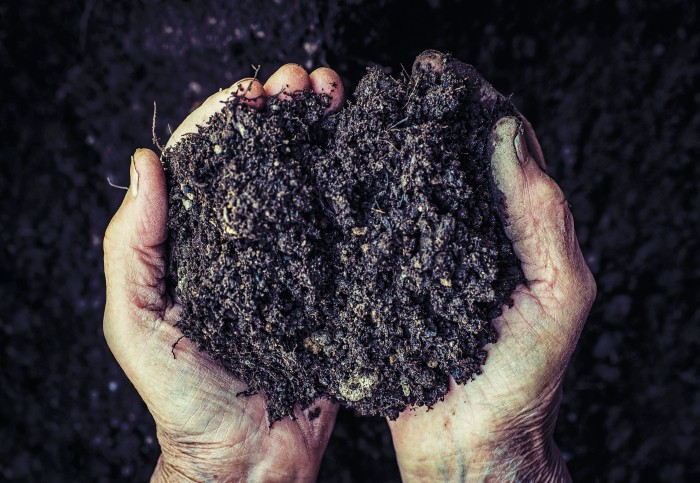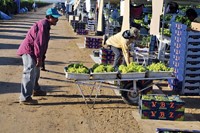Advertisement
Grab your lab coat. Let's get started
Welcome!
Welcome!
Create an account below to get 6 C&EN articles per month, receive newsletters and more - all free.
It seems this is your first time logging in online. Please enter the following information to continue.
As an ACS member you automatically get access to this site. All we need is few more details to create your reading experience.
Not you? Sign in with a different account.
Not you? Sign in with a different account.
ERROR 1
ERROR 1
ERROR 2
ERROR 2
ERROR 2
ERROR 2
ERROR 2
Password and Confirm password must match.
If you have an ACS member number, please enter it here so we can link this account to your membership. (optional)
ERROR 2
ACS values your privacy. By submitting your information, you are gaining access to C&EN and subscribing to our weekly newsletter. We use the information you provide to make your reading experience better, and we will never sell your data to third party members.
Agriculture
Regenerating degraded dirt
Efforts to boost soil carbon aim to improve crop yields and combat climate change
by Britt E. Erickson
March 7, 2016
| A version of this story appeared in
Volume 94, Issue 10
It’s hard to find a bare spot on the more than 800 acres farmed by Cory Atkins of Seaford, Del. Even in the dead of winter, a carpet of ankle-high ryegrass blankets the soil where he plans to grow soybeans in the spring. In other fields, wheat and barley sown last fall poke through the dirt next to remnants of sunflowers, clover, and radishes.
“These cover crops hold the dirt in place and put nutrients back in the ground,” Atkins says. They also increase soil organic matter—the dark material, called humus, in the top layer of dirt. That layer contains cellulose, starch, lignin, and other molecules from the decomposition of plants and animal residues, plus a slew of biochemicals produced by earthworms and other organisms that live in soil.
In brief
The world’s soils are rapidly degrading. More and more farmers are trying to reinvigorate them by increasing soil organic matter. Techniques such as planting cover crops, adopting no-till practices, and adding biochar increase organic matter, reduce erosion, enhance soil’s water-holding capacity, and help keep nutrients such as nitrogen and phosphorus from washing away. They also increase the amount of carbon dioxide that plants strip from the atmosphere, which gets locked into soil as stable organic compounds. Food companies and governments are hoping to get more farmers to adopt these practices to make agriculture more resilient to droughts and extreme weather associated with human-caused climate change.
Atkins is part of a small but growing group of farmers and agriculture specialists working to improve the health of degraded soils by increasing soil organic matter. As well as planting cover crops, these conservation-minded growers are adopting no-till practices that don’t disturb the soil. Tilling has negative effects on earthworms and other soil organisms, restricts the downward flow of water, and leads to rapid decomposition of organic matter into carbon dioxide, according to scientists at USDA’s Natural Resources Conservation Service. Some growers are also adding soil amendments—including compost, manure, and a charcoal-like substance called biochar made from pyrolysis of biomass—to soil to increase organic matter.
Scientists have found that increasing soil organic matter imparts several benefits. It improves soil structure, making the dirt crumbly and less compact so that water and air can easily move through it and plant roots can easily penetrate it. Increasing organic matter also leads to less soil erosion and enhances the water-holding capacity of soil. And it helps keep nutrients such as nitrogen and phosphorus from washing away during heavy rains.
More organic matter also increases the amount of the carbon dioxide that gets stripped from the atmosphere by encouraging more plant growth. Plants pull the greenhouse gas from the air via photosynthesis and release carbon compounds into the soil through their roots. Soil organisms then turn a fraction of that carbon into stable humus compounds, thus sequestering it.
Combating climate change
Atkins and most other farmers started growing cover crops and practicing no-till methods for reasons other than to help mitigate climate change. They typically care more about keeping their soil in place when big storms hit and bringing life back into soil that hasn’t been very productive in recent years. But experts believe that if more farmers adopted such approaches, they could store a significant amount of carbon.
Benefits of alternative farming
Cover crops, no-till farming, and carbon-rich soil amendments, such as biochar, increase soil organic matter and lead to:
▸ Less soil erosion
▸ Improved soil water-holding capacity and increased drought resilience
▸ Increased sequstration of atmospheric CO2 into soils
▸ Reduced nutrient leaching into water
▸ Enhanced soil fertility and potentially higher crop yields
Soil carbon sequestration has the potential to offset 5–15% of current global fossil-fuel emissions, according to estimates by Rattan Lal, director of the Carbon Management & Sequestration Center at Ohio State University. Lal published those estimates more than a decade ago (Science 2004, DOI: 10.1126/science.1097396).
The challenge is to get more farmers to adopt practices that enhance soil carbon. The U.S. Department of Agriculture estimates that only about 35% of cropland in the U.S. is farmed with no-till techniques. Brazil, Australia, Canada, and Argentina rely on no-till techniques at about the same rate, but the practice is less common in Europe, Africa, and Asia. “We have a huge potential carbon sink right beneath our feet, and we’re not taking advantage of it, yet,” says Debbie Barker, international programs director at the consumer advocacy group Center for Food Safety.
But that could be about to change. The idea of sequestering carbon in soil has gotten a lot of renewed attention. One effort in particular, which the French government launched at the international climate change conference in Paris last year, aims to increase the amount of carbon in soils globally by 0.4% each year. It’s called the 4 per 1,000 Initiative.
The amount of carbon in Earth’s atmosphere increases by about 4.3 billion metric tons annually from CO2 emissions associated with human activities, according to estimates by the Intergovernmental Panel on Climate Change. The world’s soil currently harbors about 1.5 trillion metric tons of organic carbon, this group of scientists estimates.
The 4 per 1,000 Initiative aims to show that a small increase in soil carbon could improve the fertility of degraded soils and boost agricultural production while helping meet the global political goal of limiting the global average temperature increase to less than 2 °C above preindustrial levels. Experts believe that temperature increases greater than that will have serious negative effects on ecosystems and human societies.
“The impacts of climate change are already making themselves felt in agriculture,” Stéphane Le Foll, the French minister of agriculture, said when he introduced the initiative last year. “Lackluster agricultural yields are now being seen for certain crops in most of the world’s regions. The increase in the frequency of extreme weather-related events will also have consequences for agricultural yields,” he noted.
The United Nations Food & Agriculture Organization estimates that as much as 40% of the world’s soil is degraded, and human-caused climate change is accelerating the pace of that degradation. The group defines soil degradation as “a change in the soil health status resulting in a diminished capacity of the ecosystem to provide goods and services for its beneficiaries.” Soil fertility needs to be restored to feed the estimated 9.5 billion people that will be on Earth in 2050, it says.
The 4 per 1,000 Initiative was not folded into the climate change agreement reached in Paris last December. However, at least 100 partners—including national, regional, and local governments; companies; research organizations; trade associations; and environmental groups—have committed to the effort under the Lima-Paris Action Agenda. The group behind this voluntary effort—led by France, Peru, and the United Nations—aims to start efforts to combat climate change before the Paris pact goes into effect in 2020.
The U.S. government has not committed to the 4 per 1,000 Initiative. Instead, USDA has its own strategy to reduce greenhouse gas emissions and enhance carbon sequestration from agricultural and forestry practices by more than 120 million metric tons of CO2 equivalent by 2025.
Big food commits

In the months leading up to the Paris climate change meeting, several global food companies made commitments to source ingredients from sustainable growers to help mitigate climate change.
For example, PepsiCo pledged to expand the use of sustainable farming practices to more than 500,000 acres used by its North American agricultural suppliers of corn, oats, potato, and citrus by the end of 2016. Coca-Cola, meanwhile, committed to reducing greenhouse gas emissions by 25% by 2020 across its supply chain and those of its global bottling partners.
And General Mills announced that it will reduce greenhouse gas emissions by 28% in its supply chain “from farm to fork to landfill” by 2025. In 2013, the company pledged to sustainably source 100% of its 10 priority ingredients by 2020. The 10 ingredients represent half of the raw materials purchased by the company.
It remains to be seen whether commitments that large food companies make will persuade farmers to adopt sustainable approaches such as planting cover crops and adopting no-till practices. Nonetheless, companies are working with a small number of growers to reduce their greenhouse gas emissions, better manage water, and improve soil quality, all in the hopes of making farms more resilient to climate change.
Profit motive?
The agriculture sector is particularly vulnerable to droughts and extreme weather events expected with a warming world. Food companies are aware of this vulnerability and taking the lead to address it because such events are bad for business, they say.
One of the challenges in getting more farmers to invest in the health of their soils is the lack of evidence showing that the strategy will improve crop yields and thus lead to higher profits.
To address this problem, the National Corn Growers Association (NCGA) is managing a five-year project called the Soil Health Partnership. It aims to measure the impact of planting cover crops and other practices intended to improve soil health. The partnership was established in 2014 with support from Monsanto and the Walton Family Foundation, as well as technical help from the Nature Conservancy, an environmental group.
“The goal is to enroll 20 farms each year over five years,” says Nicholas Goeser, director of the partnership and director of soil health and sustainability at NCGA. The effort is expanding, he says, “so that we have adequate representation from different cropping regions, climatic gradients, and soil types.”
Farmers in the program will test various methods for improving soil health on strips of their land to determine what does or does not boost productivity and crop yields.
After five years of growing cover crops on his farm in southwestern Iowa, Ray Gaesser, former president of the American Soybean Association, is beginning to see a difference. “We are seeing better water infiltration. Organic matter is being built up on the surface,” he says. So far he has not seen an increase in crop yields. But, he tells C&EN, “we believe we will in the future.”
Follow the carbon

Source: French Ministry of Agriculture
Click here to download a PDF of this graphic.
Scientists are trying to quantify the effects of farm management practices on soil carbon sequestration, greenhouse gas emissions, and environmental quality. Soil chemists at USDA’s Agricultural Research Service (ARS) have been measuring soil organic carbon and emissions of three major greenhouse gases—CO2, nitrous oxide, and methane—on test plots across the U.S. for more than a decade. Their work is part of a national network of research projects called Greenhouse Gas Reduction through Agricultural Carbon Enhancement Network (GRACEnet).
Researchers in GRACEnet are determining how various land management practices affect soil carbon content and greenhouse gas emissions from agricultural practices. They are also developing new ways of farming that reduce emissions and boost sequestration of carbon in soil. Ultimately the researchers want to develop computer models that predict the impact of land management practices on soil carbon and greenhouse gas emissions.
“The primary goal of this project is to reverse the soil organic matter lost over the last century” through cultivation practices and improve the properties and fertility of soil, says Hero T. Gollany, an ARS scientist. She studies the impacts of agricultural practices on chemical and physical properties of soil in the Pacific Northwest dryland region of the U.S. There, several decades of growing wheat and intensively tilling the land after harvest has reduced soil organic matter, she says.
Changing farming
It is unclear what it will take to get farmers to adopt methods that increase soil organic matter. Atkins, the farmer in Delaware, says he didn’t know about cash incentives from government programs or combating climate change when he planted his first cover crops and adopted no-till practices many years ago.
To Atkins, one of the big attractions of cover crops is being able to plant seeds earlier in the spring compared with when he practiced conventional tilling methods. Because something is always growing on the land, the soil is now less soggy and it warms faster in the spring, he explains.
Keeping nitrogen and phosphorus fertilizer on his fields—and not losing it in runoff—is also a big deal for Atkins, who farms in southeastern Delaware near the Chesapeake Bay. He grows hundreds of acres of corn, soybeans, and vegetables each year with his dad and helps manage six poultry houses.
“People think farmers are polluting the bay because we are so close,” Atkins says. Nitrogen and phosphorus runoff from farms has long been blamed for contributing to the bay’s water quality problems. Increased levels of nutrients in the bay lead to large algal blooms that eventually die and decompose, creating areas depleted of oxygen called “dead zones,” where the water is uninhabitable for most species.
“My soil tests show me that not much nitrogen is leaving my farms,” Atkins says. He has his soil analyzed every other year, taking 50 samples from 2-acre blocks over a 100-acre field. The results guide him in determining how much fertilizer to use each growing season. His tractor is equipped with technology that allows him to apply the right amount of fertilizer exactly where he needs it, varying the amounts across the field. By having crops growing on his land year-round, that fertilizer doesn’t get washed away.
For Gaesser, the Iowa farmer, cover crops help loosen the soil and allow it to withstand heavy rains that have become more common in the past four years. “Where we have cover crops, we get very little erosion,” he says.
Farming practices, particularly in the Midwest U.S. where little besides soybeans and corn are grown, “leave the soil open with no green growing crop for a big part of the year,” Gaesser says. “Having a cover crop or some kind of a crop for more than four months out of the year is beneficial to not only the soil health and soil carbon, but to water quality and conservation practices in keeping that soil in place.”
CORRECTION:
This story was updated on March 17, 2016. The story incorrectly said the amount of carbon dioxide in Earth’s atmosphere increases by about 4.3 billion metric tons annually. The amount of carbon in Earth’s atmosphere increases by that amount annually.






Join the conversation
Contact the reporter
Submit a Letter to the Editor for publication
Engage with us on Twitter